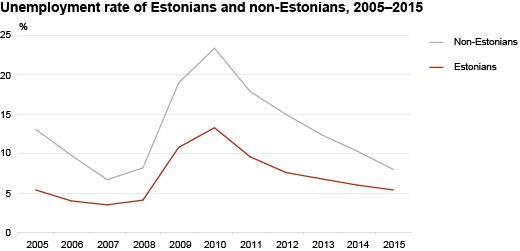Analytics, Employment, Labour-market, Markets and Companies
International Internet Magazine. Baltic States news & analytics
Thursday, 25.04.2024, 11:50
In 2015, employment rate was 65.2% in Estonia
 Print version
Print version
Compared to 2014, labour market indicators improved thanks to the results of the first three quarters, whereas in the 4th quarter the situation changed.
The data of the 3rd quarter of 2015 showed that the main labour market indicators, i.e. the labour force participation, unemployment and employment rate, were nearing a level similar to that of the economic boom. In the 4th quarter, both the labour force participation rate and the employment rate were higher than in the same quarter of the previous year, but the unemployment rate as well as the total number of unemployed persons did not decrease anymore. While in the 4th quarter of 2014 the unemployment rate was 6.3% and the estimated number of unemployed persons was 42,700, then in the 4th quarter of 2015 the corresponding indicators stood at 6.4% and 43,900.
In 2015 compared to 2014, labour market indicators improved thanks to the results of the first three quarters. Despite the fact that, compared to 2014, the total number of working-age persons (15–74-year-olds) decreased by 8,000, the number of persons actively participating in the labour market increased by 9,000, reaching an estimated 683,100 persons. The employment rate rose from 63% to 65.2% and the unemployment rate dropped from 7.4% to 6.2%. Thus, the number of inactive persons continued to decline as well, dropping to an estimated 300,500 persons by 2015. The number of persons employed has consequently increased on account of both unemployed persons and economically inactive persons who have entered the labour market.

There continue to be significant cleavages in labour market indicators depending on the place of residence, sex, age and ethnic nationality. In 2015, the highest employment rate (71%) was recorded in Harju county and the difference compared to Põlva county which had the lowest employment rate (47.6%) exceeded 20 percentage points. In addition to better job opportunities, the result was also influenced by a different age structure. Harju county also had the lowest unemployment rate (5.2%).
In 2015 compared to 2014, both the employment rate of males and that of females improved, but similarly to a previous couple of years the employment rate of males has grown faster, making the employment gap between males and females reach 8 percentage points. While in recent years the unemployment rate of males has been slightly higher than that of females, then in 2015 the gap became nearly non-existent: the unemployment rate was 6.2% for males and 6.1% for females.
In 2015 compared to 2014, the unemployment rate dropped considerably among both young people (15–24-year-olds) and those in prime working age (25–49-year-olds). The unemployment rate of elderly people (50–74-year-olds), however, remained practically the same. The unemployment rate continued to be the highest (13.1%) among young people, which indicates that entering the labour market and staying there is a serious problem for the young. At the same time, a large share of young people is still studying and is not planning to seek employment in the near future.
The employment rate has risen both for Estonians and non-Estonians, but the difference compared to 2014 has remained in the range of 5–6%, with the rate being higher in the case of Estonians. Estonians also had a lower unemployment rate, but the gap between Estonians and non-Estonians has narrowed in recent years. In 2015, the unemployment rate was 5.4% for Estonians and 8% for non-Estonians.
What could be mentioned as the possible reasons for the improved labour market indicators in 2015 compared to 2014 is the impact of the Employment Register on employment, the economic growth of 2014 and the planned Work Capacity Reform. The noticeably slower economic growth in 2015 has also probably already influenced the labour market indicators of the 4th quarter of 2015.
The unemployment rate is the share of the unemployed in the labour force (the sum of employed and unemployed persons). The employment rate is the share of the employed in the working-age population (aged 15–74). The labour force participation rate shows the share of the labour force in the population aged 15–74. The estimates are based on the data of the Labour Force Survey.
Statistics Estonia has been conducting the Labour Force Survey since 1995 and every quarter 5,000 persons participate in the survey. The Labour Force Survey is carried out by statistical organisations in all the European Union Member States on the basis of a harmonised methodology.








 «The Baltic Course» Is Sold and Stays in Business!
«The Baltic Course» Is Sold and Stays in Business!

